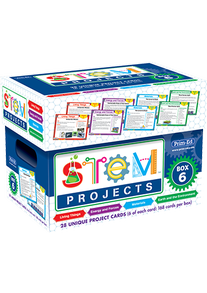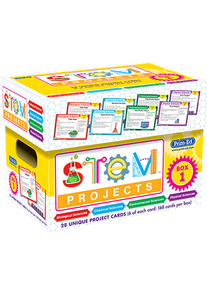-
0
Your cart is currently empty.
-
0
Your cart is currently empty.
STEM Projects
Inspire and prepare today’s pupils to become tomorrow’s innovators with STEM Projects.
The STEM Projects series provides opportunities for pupils to creatively apply skills and knowledge in a wide range of cross-curricular learning contexts. Although science is the subject area upon which most of the projects are based, other curricular areas (geography, mathematics, SPHE and visual arts) along with design and technology skills come into play in a cross-curricular fashion, depending on the project. By their very nature, these projects are group-work driven and they develop skills in communication, cooperation, problem-solving, reasoning, leadership and resilience.
Download a sample of STEM Projects
These boxes will ensure that teachers can support and complement their existing science programme of work by incorporating either a short-term or long-term project into their schedule.
What is STEM Education?
STEM education stands for Science, Technology, Engineering, and Mathematics education. It is an interdisciplinary approach to learning that combines these four subjects in order to provide students with a well-rounded education that can prepare them for careers in fields related to science and technology.
By combining these subjects, students gain a deeper understanding of each individual subject, as well as how they can be applied in real-world situations.
In a STEM curriculum, students are actively engaged in hands-on, problem-based learning that encourages critical thinking, creativity, and collaboration. This approach helps students develop the skills they need to be successful in today's rapidly changing technological world.
STEM education is designed to prepare students for careers in fields such as engineering, computer science, biotech, and renewable energy. It can also be beneficial for students who are interested in pursuing careers in other fields that require strong problem-solving and analytical skills.
How the STEM Projects series works
The STEM Projects series aims to enhance student understanding of STEM concepts through interactive and hands-on activities. Each package includes a set of cards containing activities that can be used to demonstrate STEM in the classroom.
These activities and stem challenges are created to be engaging, interactive, and meaningful to students' lives. For instance, one activity may involve students learning about plant growth by conducting experiments at home or in their garden.
Each box is divided into four colour-coded sections:
- Living Things;
- Energy and Forces;
- Materials; and
- Earth and the Environment.
The variety of projects contained within each section also allows them to be successfully incorporated into a cross-curricular approach to topic teaching. Each project allows pupils to work creatively in small groups, using effective communication and collaboration skills, to plan, design, create and evaluate a thoughtful and innovative solution to a given task.
When satisfied with their solutions, pupils are given a range of ways to showcase and discuss their designs, whilst also explaining how science was used throughout the project. The projects also contain opportunities for effective use of digital technology, including film-making, presentations, scanning QR codes and desktop (Internet) research.
Real-world applications of STEM concepts
STEM concepts have a wide range of real-world applications across various industries and fields. These include healthcare and medicine, computer science and technology, environmental science, robotics and automation, construction and many more. The application of STEM concepts is vast and encompasses many other fields and industries.
By connecting what they learnt in class and its use in everyday life, children can get a better understanding of STEM subjects, how the world works and the impact of technology and science on society.
How to Teach STEM in Your Classroom
There are several ways to teach STEM in the classroom:
- Incorporate hands-on and experiential learning: Hands-on STEM activities and experiments are a great way to make STEM skills come alive for students. This can include projects such as building a model bridge, programming a robot, or conducting a science experiment.
- Use real-world examples and applications: Connecting STEM concepts to real-world examples and applications can help students understand the relevance and importance of what they are learning.
- Use technology and digital resources: Technology can be a powerful tool for teaching STEM subjects. This can include using online resources such as videos and interactive tutorials.
- Provide opportunities for inquiry-based learning: Inquiry-based learning allows students to explore and discover STEM concepts on their own. This can include age appropriate activities such as open-ended experiments, research projects, and problem-based learning.
- Provide opportunities for students to explore different STEM fields: STEM subjects are diverse, and it's important to provide opportunities for students to explore different fields. This can include inviting guest speakers, taking field trips, and providing opportunities for students to participate in competitions and events.
Overall, teaching STEM in the classroom requires a hands-on, interactive, and inquiry-based approach that incorporates real-world examples, technology, and teamwork. It also requires an ongoing effort to stay current with the latest developments in STEM education.
Explore how to use stem projects in your classroom
Fun STEM activities your pupils will love
The series offers students a range of opportunities to creatively explore concepts in science, technology, engineering, and mathematics.
Some of the highlights of the series include:
- In Biological Sciences: Students can design and create a miniature worm farm, design a video that demonstrates different types of human movement and create a garden to grow a radish from seed to harvest.
- In Chemical Sciences: Students can design and build a pirate ship that floats, make a set of bubble wands from pipe cleaners, and create an ice sculpture.
- In Environmental Sciences: Students can design and build a water slide, a model of a national park, and a soil erosion demonstrator.
- In Physical Sciences: Students can design and make a cardboard maze game, stringed instruments, and a hoverboard model using the science of magnetic repulsion.
Overall, the series provides students with a variety of activities and projects that allow them to apply the concepts they learn in STEM to creative and hands-on challenges.
Benefits of the STEM Projects series
The STEM Projects series offers a unique opportunity for students to learn about science, technology, engineering, and mathematics through interactive and engaging activities and experiments.
This series can assist students in:
- Understanding the real-world applications of STEM concepts such as robotics and coding, which are vital for comprehending the complex world we live in.
- Improving their problem-solving and critical thinking skills, which are essential for future careers in STEM fields.
Additionally, the series also benefits teachers and educators by providing:
- Projects and experiments that are aligned with the curriculum and are designed keeping in mind the teachers' needs
- Detailed instructions for conducting each project safely and effectively
- STEM challenge cards, lesson materials, activities, and worksheets for easy assessment
The STEM Projects series helps primary school teachers gain a deeper understanding of the principles behind each project, providing students with a better insight into how science can be applied in real-life scenarios.
STEM resources from Prim-Ed Publishing
If you are searching for ways to create lessons that engage your students with STEM subjects, Prim-Ed Publishing offers a wide variety of high-quality science, design and technology teaching resources.
Senior Infants in Catherine McAuley JNS making the Rope Bridge project from the Infants box:
Frequently asked questions
What is STEM Education?
STEM education refers to the integration of Science, Technology, Engineering, and Mathematics in the classroom. It is designed to provide students with a well-rounded education that prepares them for careers in fields related to science and technology.
How does the STEM Projects series help students?
The STEM Projects series is an interactive and hands-on way to help students understand and apply STEM concepts. Each package includes a set of STEM activities that can be used to demonstrate STEM in the classroom. The activities are designed to be engaging, interactive, and meaningful to students' lives.
How are STEM concepts used in the real world?
STEM concepts have a wide range of applications in various industries and fields, including healthcare, computer science, environmental science, robotics, construction, and more. They are widely used in everyday life.
How can I incorporate STEM education in my classroom?
There are several ways to teach STEM in the classroom, such as incorporating hands-on, problem-based learning activities, promoting critical thinking, creativity, and collaboration, and connecting classroom learning to real-world applications. The STEM Projects series can also be used as a supplement to existing science programs. Additionally, you can also download a free sample and explore how to use STEM Projects in your classroom.














